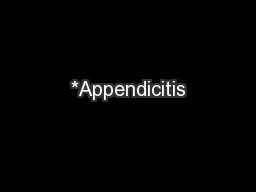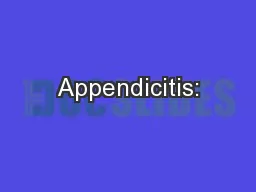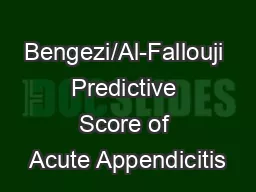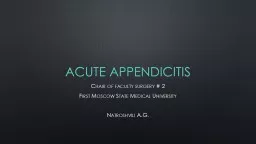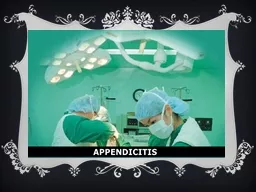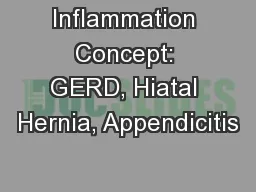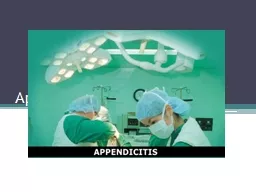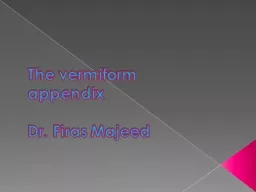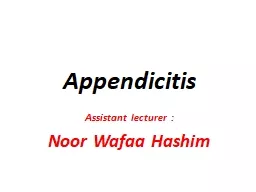PPT-*Appendicitis
Author : tatiana-dople | Published Date : 2016-04-26
Gastroenteritis Peritonitis Ulcerative Colitis Crohns Disease Diverticular Disease Gallbladder Disease Acute and Chronic Inflammatory Bowel Disorders and Bowel
Presentation Embed Code
Download Presentation
Download Presentation The PPT/PDF document "*Appendicitis" is the property of its rightful owner. Permission is granted to download and print the materials on this website for personal, non-commercial use only, and to display it on your personal computer provided you do not modify the materials and that you retain all copyright notices contained in the materials. By downloading content from our website, you accept the terms of this agreement.
*Appendicitis: Transcript
Gastroenteritis Peritonitis Ulcerative Colitis Crohns Disease Diverticular Disease Gallbladder Disease Acute and Chronic Inflammatory Bowel Disorders and Bowel Diseases Appendicitis. Appendicitis is the leading cause of emergency abdominal operations 1 Spirt MJ Complicated intraabdominal infections a focus on appendicitis and diverticulitis Postgraduate Medicine 201012213951 What is the appendix The appendix is a 64257ngerlike p When simple becomes not so simple. Jeffrey C. Pence, . MD, FACS, FAAP. Associate Professor . of . Surgery. Department of Surgery. Dayton Children’s Medical Center. Elizabeth H. Ey, MD. Associate Clinical Professor of Pediatrics. The New International Gold Standard. . Professor Mohannad Al-Fallouji, PhD (London), FRCS, FRCSI. . . . Director: . www.ihams.org. . Director: . www.qamoosalfordous.wordpress.com. Chair of faculty surgery # 2 . First Moscow State Medical University. Natroshvili A.G.. Anatomy and function. First visible in the 8. th. week of life – protuberance off the terminal ileum. Base of the appendix arises from the posteromedial aspect of the cecum. Definition. The appendix is a small, finger-like appendage attached to. the cecum just below the . ileo-cecal. . valve. .. It empties into . the colon inefficiently and its lumen is . small; . it is . Hinkle . ch.. 46 & 48. Gastroesophageal. Reflux Disease (GERD) (1253). Backflow of gastric contents into esophagus. . Incidence increases with age. Affects infants as well but is referred to as GER. to the . cecum just below the . ileo-cecal. . valve. .. It empties into . the colon inefficiently and its lumen is . small; . it is . prone to . becoming obstructed and is vulnerable to . infection (appendicitis).. Firas. . Majeed. . . . Acute . appendicitis is the most common cause of an ‘acute abdomen’ in young . adults. . Appendicitis is sufficiently common that . appendicectomy. (termed ‘appendectomy’ in North America) is the most frequently performed urgent abdominal operation and is often the first major procedure performed by a surgeon in training. Ahmet Nuray TURHAN Selin KAPAN Ersen KTK Hakan YTBA Sinan HATPOLU Eran AYGNBu prospektif almada akut apandisitte konservatif tedavi ve cerrahi tedavinin gvenilirlik ve etkinlik asndan karBakrky Dr Sad Noor Wafaa Hashim. Epidemiology. Commonest . cause of an acute abdomen and surgical admission in the UK.. Approximately . one. in . seven . people will have an . appendicectomy. .. It most commonly occurs between . Perforation in acute appendicitis: Evaluation of hyperbilirubinemia and elevated C reactive protein as a predictive factor . IAIM, 2017; 4 (3 ): 18 - 23. Page 18 Original Research Article Perforatio Adıyaman University Faculty of Medicine, Training and Research Hospital, Department of Radiology, Adıyaman-TurkeyABSTRACTBACKGROUND: The purpose of the present study was to investigate the diagnosti 3 3 DOI: 10.7860/JCDR/2019/42059.13090 Case Report Surgery Section Right Psoas Abscess as a Consequence of Ruptured Appendix with Caecal Perforation and Presenting as Right Lumbar Swelling in a CAS Ulus Travma Acil Cerrahi Derg, March 2016, Vol. 22, No. 2Mert Mahsuni Sevinç, M.D., Erdem Kınacı, M.D., Ekrem Çakar, M.D., Savaş Bayrak, M.D.,Abdulkerim Özakay, M.D., Acar Aren, M.D., Serkan Sar
Download Rules Of Document
"*Appendicitis"The content belongs to its owner. You may download and print it for personal use, without modification, and keep all copyright notices. By downloading, you agree to these terms.
Related Documents

